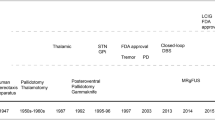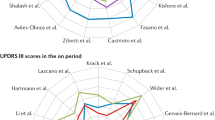Abstract
Throughout the past decade, there has been a marked increase in surgical therapies, primarily deep brain stimulation (DBS), for the treatment of advanced Parkinson’s disease (PD). DBS of the thalamus has been shown to be effective in reducing parkinsonian tremor; however, it is not the treatment of choice for PD given the progression of other symptoms such as rigidity and bradykinesia. Stimulation of the globus pallidus or the subthalamic nucleus is safe and efficacious in the long-term treatment of all cardinal symptoms of PD, and they are currently the surgeries of choice. Serious adverse events with DBS can occur in 1% to 2% of patients, infection in 5% to 8% of patients, and hardware complications in approximately 25% of patients. Complications associated with DBS are related to the experience of the surgical center. Referring physicians and patients should be aware of the number of surgical procedures and complication rates of any prospective surgical center.
Similar content being viewed by others
References and Recommended Reading
Olanow CW, Watts RL, Koller WC: An algorithm (decision tree) for the management of Parkinson’s disease (2001): Treatment guidelines. Neurology 2001, 56(suppl 5):S1-S88.
Samuel M, Lang AE: Lesion surgeries. In Handbook of Parkinson’s Disease. Edited by Pahwa R, Lyons KE, Koller WC. New York: Marcel Dekker; 2003:463–495.
Alesch F, Pinter MM, Helscher RJ, et al.: Stimulation of the ventral intermediate thalamic nucleus in tremor dominated Parkinson’s disease and essential tremor. Acta Neurochir 1995, 136:75–81.
Benabid AL, Pollak P, Gao D, et al.: Chronic electrical stimulation of the ventralis intermedius nucleus of the thalamus as a treatment of movement disorders. J Neurosurg 1996, 84:203–214.
Pollak P, Benabid AL, Limousin P, Benazzouz A: Chronic intracerebral stimulation in Parkinson’s disease. Adv Neurol 1997, 74:213–220.
Koller W, Pahwa R, Busenbark K, et al.: High-frequency unilateral thalamic stimulation in the treatment of essential and parkinsonian tremor. Ann Neurol 1997, 42:292–299.
Limousin P, Speelman JD, Gielen F, Janssens M: Multicentre European study of thalamic stimulation in parkinsonian and essential tremor. J Neurol Neurosurg Psychiatry 1999, 66:289–296.
Albanese A, Nordera GP, Caraceni T, Moro E: Long-term ventralis intermedius thalamic stimulation for parkinsonian tremor. Italian Registry for Neuromodulation in Movement Disorders. Adv Neurol 1999, 80:631–634.
Kumar K, Kelly M, Toth C: Deep brain stimulation of the ventral intermediate nucleus of the thalamus for control of tremors in Parkinson’s disease and essential tremor. Stereotact Funct Neurosurg 1999, 72:47–61.
Hariz MI, Shamsgovara P, Johansson F, et al.: Tolerance and tremor rebound following long-term chronic thalamic stimulation for Parkinsonian and essential tremor. Stereotact Funct Neurosurg 1999, 72:208–218.
Lyons KE, Koller WC, Wilkinson SB, Pahwa R: Long term safety and efficacy of unilateral deep brain stimulation of the thalamus for parkinsonian tremor. J Neurol Neurosurg Psychiatry 2001, 71:682–684. This study demonstrates the long-term tremor control provided by DBS of the thalamus while also illustrating that other symptoms continue to progress, reducing the functional ability of patients. This paper highlights the fact that thalamic DBS is not the treatment of choice for typical Parkinson’s disease.
Rehncrona S, Johnels B, Widner H, et al.: Long term efficacy of thalamic deep brain stimulation for tremor: double blind assessments. Mov Disord 2003, 18:163–170. This study demonstrates the long-term tremor control provided by DBS of the thalamus while also illustrating that other symptoms continue to progress, reducing the functional ability of patients. This paper highlights the fact that thalamic DBS is not the treatment of choice for typical Parkinson’s disease.
Kumar R, Lang AE, Rodriguez-Oroz MC, et al.: Deep brain stimulation of the globus pallidus pars interna in advanced Parkinson’s disease. Neurology 2000, 55:S34-S39.
The Deep Brain Stimulation for Parkinson’s Disease Study Group: Deep brain stimulation of the subthalamic nucleus or the pars interna of the globus pallidus in Parkinson’s disease. N Engl J Med 2001, 345:956–963.
Ghika J, Villemure JG, Fankhauser H, et al.: Efficiency and safety of bilateral contemporaneous pallidal stimulation (deep brain stimulation) in levodopa-responsive patients with Parkinson’s disease with severe motor fluctuations: a 2-year follow-up review. J Neurosurg 1998, 89:713–718.
Volkmann J, Sturm V, Weiss P, et al.: Bilateral high-frequency stimulation of the internal globus pallidus in advanced Parkinson’s disease. Ann Neurol 1998, 44:953–961.
Loher TJ, Burgunder JM, Pohle T, et al.: Longterm pallidal deep brain stimulation in patients with advanced Parkinson’s disease: 1 year follow-up study. J Neurosurg 2002, 96:844–853.
Lyons KE, Wilkinson SB, Troster AI, Pahwa R: Long-term efficacy of globus pallidus stimulation for the treatment of Parkinson’s disease. Stereotact Funct Neurosurg 2002, 79:214–220. This study demonstrates that the benefits obtained from DBS of the GPi are sustained for at least 48 months.
Limousin P, Krack P, Pollak P, et al.: Electrical stimulation of the subthalamic nucleus in advanced Parkinson’s disease. N Engl J Med 1998, 339:1105–1111.
Kumar R, Lozano AM, Kim YJ, et al.: Double-blind evaluation of subthalamic nucleus deep brain stimulation in advanced Parkinson’s disease. Neurology 1998, 51:850–855.
Rodriguez-Oroz MC, Gorospe A, Guridi J, et al.: Bilateral deep brain stimulation of the subthalamic nucleus in Parkinson’s disease. Neurology 2000, 55:S45-S51.
Thobois S, Mertens P, Guenot M, et al.: Subthalamic nucleus stimulation in Parkinson’s disease: clinical evaluation of 18 patients. J Neurol 2002, 249:529–534.
Moro E, Scerrati M, Romita LM, et al.: Chronic subthalamic nucleus stimulation reduces medication requirements in Parkinson’s disease. Neurology 1999, 53:85–90.
Molinuevo JL, Valldeoriola F, Tolosa et al.: Levodopa withdrawal after bilateral subthalamic nucleus stimulation in advanced Parkinson disease. Arch Neurol 2000, 57:983–988.
Tavella A, Bergamasco B, Bosticco E, et al.: Deep brain stimulation of the subthalamic nucleus in Parkinson’s disease: longterm follow-up. Neurol Sci 2002, 23(suppl 2):S111-S112.
Figueiras-Mendez R, Regidor I, Riva-Meana C, Magarinos-Ascone CM: Further supporting evidence of beneficial subthalamic stimulation in Parkinson’s patients. Neurology 2002, 58:469–470.
Vingerhoets FJ, Villemure JG, Temperli P, et al.: Subthalamic DBS replaces levodopa in Parkinson’s disease: two-year follow-up. Neurology 2002, 58:396–401.
Romito LM, Scerrati M, Contarino MF, et al.: Long-term follow up of subthalamic nucleus stimulation in Parkinson’s disease. Neurology 2002, 58:1546–1550.
Pahwa R, Wilkinson SB, Overman J, Lyons KE: Bilateral subthalamic stimulation in patients with Parkinson disease: long-term follow up. J Neurosurg 2003, 99:71–77.
Kleiner-Fisman G, Fisman DN, Sime E, et al.: Long-term follow up of bilateral deep brain stimulation of the subthalamic nucleus in patients with advanced Parkinson disease. J Neurosurg 2003, 99:489–495.
Krack P, Batir A, Van Blercom N, et al.: Five-year follow-up of bilateral stimulation of the subthalamic nucleus in advanced Parkinson’s disease. N Engl J Med 2003, 349:1925–1934. This study demonstrates that significant benefits obtained from DBS of the subthalamic nucleus are sustained up to 5 years after surgery.
Krack P, Pollak P, Limousin P, et al.: Subthalamic nucleus or internal pallidal stimulation in young onset Parkinson’s disease. Brain 1998, 121:451–457.
Burchiel KJ, Anderson VC, Favre J, Hammerstad JP: Comparison of pallidal and subthalamic nucleus deep brain stimulation for advanced Parkinson’s disease: results of a randomized, blinded pilot study. Neurosurgery 1999, 45:1375–1382.
Volkmann J, Allert N, Voges J, et al.: Safety and efficacy of pallidal or subthalamic nucleus stimulation in advanced PD. Neurology 2001, 56:548–551.
Scotto di Luzio AE, Ammannati F, Marini P, et al.: Which target for DBS in Parkinson’s disease? Subthalamic nucleus versus globus pallidus internus. Neurol Sci 2001, 22:87–88.
Krause M, Fogel W, Heck A, et al.: Deep brain stimulation for the treatment of Parkinson’s disease: subthalamic nucleus versus globus pallidus internus. J Neurol Neurosurg Psychiatry 2001, 70:464–470.
Beric A, Kelly PJ, Rezai A, et al.: Complications of deep brain stimulation surgery. Stereotact Funct Neurosurg 2001, 77:73–78.
Kondziolka D, Whiting D, Germanwala A, Oh M: Hardwarerelated complications after placement of thalamic deep brain stimulator systems. Stereotact Funct Neurosurg 2002, 79:228–233.
Umemura A, Jaggi JL, Hurtig HI, et al.: Deep brain stimulation for movement disorders: morbidity and mortality in 109 patients. J Neurosurg 2001, 98:779–784.
Oh MY, Abosch A, Kim SH, et al.: Long-term hardware-related complications of deep brain stimulation. Neurosurgery 2002, 50:1268–1276. This paper demonstrates a hardware complication rate of approximately 25% with DBS.
Author information
Authors and Affiliations
Rights and permissions
About this article
Cite this article
Lyons, K.E., Pahwa, R. Deep brain stimulation in Parkinson’s disease. Curr Neurol Neurosci Rep 4, 290–295 (2004). https://doi.org/10.1007/s11910-004-0054-0
Issue Date:
DOI: https://doi.org/10.1007/s11910-004-0054-0




